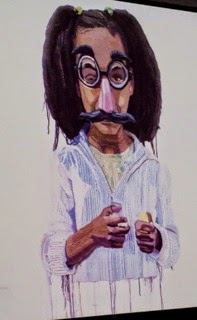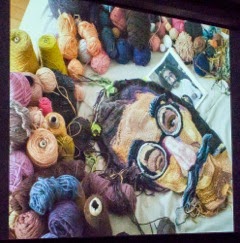 |
| Jo Hamilton prepares to address the CQA audience |
Jo Hamilton, from Portland, Oregon via Glasgow, Scotland, fascinated
a well-attended May 10 CQA meeting with insights into her process and resulting
artwork. Many in the audience had
seen at least one of Jo’s pieces in person-- the memorable, more-than-life-size
male nude in crochet form exhibited at the Bellevue Art Museum last year as
part of High Fiber Diet.
 |
| Hamilton's piece shown in BAM's "High Fiber Diet" exhibit |
Jo was always interested in color and pattern and went to
art school wanting to do portraits and landscapes. Although she had learned to
crochet from her grandmother (never advancing beyond the “granny square”), she
resisted using textiles in her art for some time, pursuing painting instead.
After moving to Portland, Jo saw an exhibit at the Portland
Craft Museum called “Not Your Grandmother’s Doily,” a collection of art made
using craft techniques. This inspired her to turn a sketch of the Portland
cityscape into an ambitious cityscape-crochet project that she worked on for
two years, on and off.
 |
| Hamilton's sketch... |
This 5 x 10-foot piece was very
exploratory, and was originally square in format. It was originally pinned to
the wall before she developed her process of mounting pieces to hardware cloth
supports. (See Jo’s website, linked below, where you’ll find an image of this
piece on the main page.) To enable shipping such a large piece, she makes the
hardware cloth support system in panels that hinge together.
 |
| ...turned into a large crocheted piece |
One of Jo’s coworkers at a restaurant teased her about
“crocheting all the way to Gresham,” a Portland suburb, and her response of “Shut
up, or I’ll crochet you!” ended up inspiring her to attempt a crochet
portrait. She had not tried curves or
facial features before, so she started by collecting photographic images of her
coworkers, which led to a series of portraits approximately twice life size.
 |
| One of Hamilton's fellow restaurant workers |
Jo explained that the size of the portraits ends up being
the result of how much detail you can get with a single stitch of crochet. Her
pieces build out, generally starting from the eye. She uses all kinds of
yarn—in the early years, almost all was from thrift stores, so most of it is
budget yarn. The color and value are more important than the fiber content.
She ended up with a dozen portraits of her friends and
colleagues from the restaurant staff, created in 2006-2008, and they were
exhibited at the Stumptown Coffee Shop in 2009.
 |
| Part of the display at Stumptown Coffee... |
 |
| ...that led to a further display in NY City |
(A show in a NY
coffee shop in 2010 ended up on television when HBO filmed an episode of Girls there.) The coffee shop show led to her being
featured on Oregon Art Beat, which led to her current show at the Schnitzer
Museum in Eugene.
After the series featuring restaurant workers, Jo began a
new series she called Mug Shots, based on photos of people arrested in
Multnomah County. She looks at these as a way of humanizing people caught at a
bad time in their lives—“They could be anyone,” she says.
 |
| One of Hamilton's "Mug Shots" pieces |
 |
| Another of the "Mug Shots" series |
By the time she did
this series, she had developed techniques to make the work more detailed and
painterly, mixing yarns as if they were paints to get intermediate colors.
Jo
has also made commissioned works. She did two dog portraits for her landlord
(animals also fell into the “not again” category after that—challenging
contours plus too much black and white!).
A newer series portrays only women, all in masks of some
kind.
 |
| Above and below: Some in the new "masks" series |
Jo brought some in-process photos of those to the meeting so
we could see how the pieces develop.
Another relatively recent development was a
display in a fancy department store in Paris.
She made masks for mannequins and placed them against the Portland
cityscape, with some additions she created to represent both Paris and London. The
display was hanging for six months.
 | ||
| One of the pieces for a Paris department store |
 |
| Hamilton placed some of her pieces in cityscapes |
Jo’s latest work is still somewhat experimental. Based on a
photo taken of an image on a television screen, it is pixellated enough that the
image is obscured--quite a contrast from her previous work. She considers this the first in a series of
more abstract work that she’s interested in exploring.
 |
| One of the newer experimental pieces |
Most of Jo’s work is characterized by the loose yarn ends
that hang vertically from the edges of each piece. She
simply got used to seeing them on the works in progress and ended up keeping
them that way. The exception is a piece made from recycled plastic bags, where
the “yarn” did not hang gracefully. (That material was also really hard on her
hands, so fell into the “not again” category of artistic experiments.)
 |
| Loose yarns are characteristic of Hamilton's pieces (Front) |
 |
| (Back of the same piece) |
Jo likes working out of her home and she shared photos of
her work space, which is the front room of her house. She spreads out
her large pieces and work on a sheet or on the floor. To gain perspective, and
some distance from the work, she stands on a chair and photographs it from
above.
 |
| Hamilton's work space is also the front room of her home. |
 |
| View of some of Hamilton's yarn "stash" |
Because Jo’s pieces are large and not extremely portable, for
the CQA program she ended by showing a few modular pieces of some of her work
so the group could experience them in person. But if you are in Eugene between now and August 3, 2014, you can see some of her work at the
Jordan Schnitzer Museum of Art.
 |
| Above and below: CQA members get to view some of Hamilton's modular pieces in person. |
For more information and better images of Jo’s work, see her
web site: http://www.johamiltonart.com/.
To see a stop-animation video Jo made to illustrate her process, go here: http://vimeo.com/41159734. It’s more than worth the 30 seconds it will take
to view it (IF you can watch it just once!).




